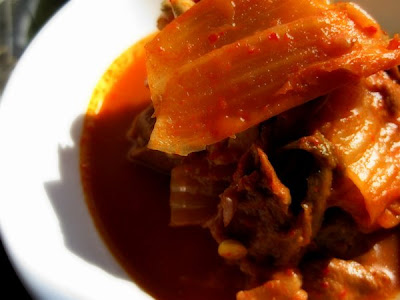Kimchi Stew (김치 찌개)
I know, I have an unhealthy obsession with kimchi. But this is my favorite type of cooked kimchi! Totally different from raw kimchi, no?
Kimchi stew (김치 찌개) is a deliciously delicious dish that is best when piping hot (tongue-scorchingly hot) and loaded with lots of cabbage kimchi (my favorite kind) and Spam. That's right, I said Spam. I love Spam, don't you know.
I think Spam adds the perfect amount of salty mysteriousness to kimchi jjigae. I don't know what Spam's made of, nor do I care. Please don't tell me, because I'll just be sad.
Kimchi jjigae is generally made with kimchi that is super fermented, so ripe that it stinks to high heaven. The cooking, boiling action transforms the texture of the kimchi (whether it's cabbage or radish or sprouts) into something meltingly good. The dense crunch of kimchi takes on a softer, more delicate mouthfeel. I'm drooling just thinking about it.
It's a very basic recipe that people don't write down.
- Kimchi in a pot.
- Add water to cover (more in my family because my dad and I love the soupy part of stews).
- Add fermented chili paste (고추장) to taste- heaps of it for my family, since we all like the spicy.
- Throw in whatever's handy (today's version has bean sprouts, a food famous in my hometown of Jeonju, and thin slices of lean beef).
- Boil away!
- Taste. Add seasonings as needed, whatever you want (I'm partial to soy sauce or fish sauce, my mother just adds more chili paste).
The thickness of the kimchi jjigae should be more viscous than a soup but not as thick as a gravy. I think the word 'stew' is a bit over-used in English and covers too much ground; there are extremely thin stews and very thick stews. I don't think it really matters very much for kimchi jjigae (or any other kind of Korean stew) because it's a personal preference. I actually like my kimchi jjigae a touch on the thin side, so the liquid is easier to drink. Kind of like a good Japanese shio ramen.

I'm actually a big fan of adding very firm tofu into kimchi jjigae, but we didn't have any, so it stayed out. Doesn't hurt the dish at all.
I've had kimchi jjigae with ramen (sometimes spelled ramyeon, definitely spelled 라면) noodles in it, cooked in the kimchi juices-- yum for the days you want to pig out like a complete oinker.
Kimchi jjigae with dumplings (the thin-skinned gyoza dumplings, not the bigger bao dumplings, called 만두 in Korean) is also very good, but extremely filling. I can't get more than about three dumplings down if I want to also eat any of the kimchi.
Kimchi jjigae is delicious in all its forms, and I even tolerate it when made with kimchis that I would not eat raw. Cooking dilutes the flavors of kimchi, melds them in a way with the chili paste that makes all kimchis palatable. (Chili pastes vary a lot. Good chili paste is to be treasured and sought out!)

A previous post about another dish made with kimchi, kimchi pancakes (김치전).
I have so many pictures to post about my uncle's stay with us, but have been far too lazy to upload and organize and such. I will try to do this soon so that my family in Korea can see...




4 comments:
made kimchi jjigae yesterday with your guidance. it was awesome. thanks!
Yay! ^^
I hope you had Spam!
used bacon. spam is expensive!
I know ... it's so wrong how expensive it is in Korea.
Bacon's good, too, of course!
Post a Comment